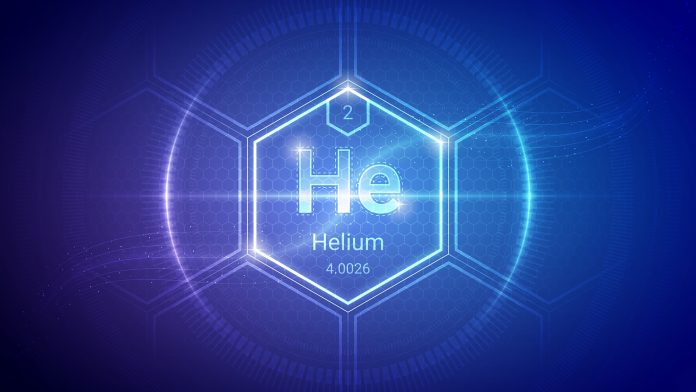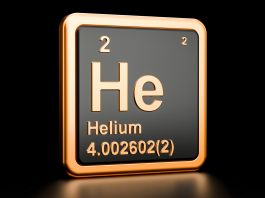Professor Jon Gluyas, Director of the Durham Energy Institute, and Professor Chris Ballentine, Chair of Geochemistry at the University of Oxford discuss the evolution of helium exploration and the importance of avoiding the associated greenhouses gases.
Helium, ‘the gas that would not burn’ is supplied by a global industry founded on an accidental falsehood. Despite carrying a huge, associated carbon footprint it is proving critical for the energy transition to net zero.
Not only are the societal aspects of human helium use weird, its physical properties also mark it out as extreme. Helium has a smaller atomic radius than hydrogen although it outweighs hydrogen by four, or less commonly three to one, its two electrons forming a closed shell bound to its two protons unlike the single proton electron pair of hydrogen.
This closed shell of electrons is not unique. The other noble gases, neon, argon, krypton, xenon, and radon are similarly endowed but none of these elements have their electrons so tightly bound as helium and their nuclei contain more protons and neutrons.
The atomic structure of helium is reflected in some other properties. Under normal atmospheric pressure, helium exists only as a gas or liquid (at near to absolute zero temperature) and never as a solid. Solid helium can be produced but only under significant pressure. Helium could be described as having no chemistry, since it will not share, donate, or accept electrons, although bizarrely it will form stable compounds at huge pressures without losing, gaining, or sharing electrons.
Helium, after hydrogen, is the second most abundant element in the Universe, but on Earth it is exceedingly rare. The atmosphere contains around five parts per million (ppm) and every helium atom in the atmosphere is on its way to outer space. The Earth’s gravity is not strong enough to prevent its escape.
Sea water is essentially helium free, containing only a few parts per trillion. The source of helium on Earth is the planet itself and although when considered as a whole the solid Earth has a helium concentration less than that of the atmosphere, helium distribution is heterogeneous, it occurs in ‘clumps’ or rather pools, typically co-existing with other gases in porous rocks beneath the Earth’s surface.
There are two naturally occurring isotopes of helium, 3He and 4He. 3He is much less abundant than 4He and on Earth it is from the formation of the planet whereas 4He is being produced continuously from the radioactive decay of thorium and uranium. Such elements tend to be enriched in granitic rocks and the older the rock, the more helium it has produced. The rest of this article is about 4He. 3He is so rare and hence expensive that its uses, though diverse, are limited in scale.
Helium has many uses; leak detection, as a cryogenic fluid, situations in which an inert atmosphere is required, as a breathing mixture with oxygen, for leak detection, in some welding technologies and as a safe lift gas for blimps and balloons, including of course party balloons.
The history of helium exploration
As a light gas like hydrogen, helium can be used for lifting blimps but unlike hydrogen it is inert and not prone to explosion. This key property did not go unmissed by the British Admiralty in WWI. Helium had been discovered back in the 1868 by Joseph Norman Lockyer but in the spectrum of the Sun rather than on Earth.
It was not until 1903 that significant quantities were found on Earth at Dexter in Kansas. While prospecting for petroleum, drillers penetrated a gas column and, as was normal back then, attempts were made to ignite the gas plume billowing from the well. This failed, the gas would not burn. Analysis showed it to contain a little methane (natural gas as it is commonly referred to) together with nitrogen and carbon dioxide. That accounted for about 98% of the gas. Almost all of the remaining 2%, after much analysis, was found to be helium with traces of other noble gases.
Helium was viewed to be little more than a novelty, that is, until the early days of WWI. A fighter pilot from Britain’s Naval Air Service shot down a German airship using incendiary bullets; no explosion ensued. The Admiralty assumed that the airship was filled with helium and not hydrogen. The British Empire was scoured for helium sources. Only as WWI ended was some found, produced, and refined in eastern Canada.
Germany had not found helium. The airship was filled with hydrogen, and it simply did not catch fire. No matter, helium had been proven as a strategic element with military applications. The hunt was on to find more; both the US and the Soviet Union sampled and analysed producing gas wells. Helium was found in many, but few matched the concentration seen in the Dexter well.
Typically, helium is present in trace quantities in most natural gas (methane) accumulations but often in such low concentrations that it is simply not economic to remove it. The nationwide search for helium by the US following WWI resulted in a number of discoveries, but it was the giant Hugoton-Panhandle field which stretches over 200 miles from Kansas in the north, through north-west Oklahoma and into northern Texas, which stole the show.
Its gas is on average 0.3% helium and although a few other accumulations were found with higher concentrations, it became the nation’s and ultimately the world’s main helium source for the best part of a century. The field was produced, methane stripped out and the methane sold.

Some helium was also sold, and some was buried at an underground facility in Amarillo, Texas. This National (or Federal) Reserve could hold up to one billion cubic meters of helium in an underground, sealed reservoir called Bush Dome. The US had a near global monopoly of tradable helium.
Uses for helium grew over the following decades and in the past decade there have been frequent supply crises. Production from US reservoirs and from storage has struggled to meet demand. The situation has been exacerbated because it is rarely possible to replace helium with substitutes and, since helium will escape, it leaks from just about any container.
The market for helium demand
Two markets in particular show massive growth in helium demand, inert atmosphere manufacturing and medical cryogenics. For example, computer chips and fibre optics need to be made under an inert atmosphere and MRI scanners require the near absolute temperature of liquid helium so that the super conducting magnets are maintained at their full working potential.
In the early years of the new millennium, two more nations became helium producers and exporters. Algeria was first, separating helium at 0.19% from the giant Hassi R’Mel gas field and then Qatar from the world’s largest gas field North Dome where helium only makes up 0.04% of the gas. Today Qatar supplies around 30% of global helium production and Algeria around 15%. Both supplies are possible because gas is exported from Qatar and Algeria as liquified natural gas (LNG) with helium being ‘knocked out’ as a byproduct of the cryogenic process to produce LNG.
In summary, helium is a critically important gas with supply issues. It has many uses including medical cryogenics and to enable the manufacturer of materials for a zero/low carbon future.
However, should humanity manage to realise that future, free of fossil fuels, then supply of helium, extracted from natural gas deposits would cease. As things stand, the current global helium industry has a collateral carbon footprint from the coproduced natural gas of over 300 million tonnes per year and that puts it in the worst 10% of countries for greenhouse gas emission!
The search for helium
Recognising both the supply problem and the collateral GHG issue a team of scientists from Durham and Oxford universities in the UK and supported by the Norwegian company now called Equinor embarked on a quest to develop a helium exploration strategy. We examined helium source rocks and the migration of helium from crystals within the source rocks to gas accumulations. We deduced the mechanisms for helium release and how the transformations occur, from it lying within solid crystal lattices, to a super dilute species in crustal (connate) water and ultimately concentrated within a free gas phase.
That all global helium production has come from separating it from natural gas (methane) does not mean that all future helium production needs to come from natural gas discoveries. Humans have discovered helium by accident when searching for natural gas (methane). To the best of our knowledge, no one had ‘boldly gone’ in search of a new helium province, especially one devoid of petroleum – we did.
In the early days of our research, accessing helium bearing gas samples proved excruciatingly difficult. We tracked down old reports in which helium was mentioned as a trace component of discovered gas. Some proved to be false trails; helium was reported in error. In other instances, companies supplied sealed gas samples from wells but those proved useless, the helium had escaped over time – just as it does from party balloons.
Then a breakthrough occurred. We obtained permission to sample known helium containing gases in an Asian country. Logistics were planned, visas obtained, and instrumentation shipped out. We were about to fly before plans were dashed by a significant security issue.
Diveena (Di) Danabalan, the PhD student assigned to the project tried a different approach and cast the net for helium bearing gas samples even wider, by launching a website to promote the quest. Bingo!
Di was contacted by the Sears brothers in the US, independent helium producers operating in mid-west US. This time gas samples were obtained, and both their geochemistry and isotopic compositions analysed. The results formed the basis for a paper given at a Goldschmidt Conference in 2015.
Finding helium in Tanzania
Around the same time, Tom Abraham-James was based in Tanzania as a mineral’s explorer and Josh Bluett, a petroleum explorer, was visiting.
As they travelled through the bush, he thumbed through an old worn book describing the mineral wealth of Tanzania. One paragraph caught his eye, helium bearing gases has been reported back in the 1960s, cold gas seeps bubbling through the water of an ephemeral lake in the Lake Rukwa area. Bluett was aware of the value of helium and contacted us to question if Tanzania, and the Lake Rukwa area in particular, might be good places to look for helium.
They were right. East Africa contains ancient granitic rocks and has in recent geological times been subject to rapid heating as part of the East African Rift. An ideal combination for the generation and release of helium. Oxford post-doc Pete Barry travelled to Rukwa in December 2015. Samples obtained were rushed back to the lab in Oxford.
The results were stunning, and the late spring 2016 version of the Goldschmidt Conference chosen as the release event. The sampled gases were basically mixes of nitrogen and helium with typical helium concentrations of 10%, some 30 times higher concentration than gases considered economically viable for helium extraction in the US and around 250 times richer in helium than Qatari gas! Moreover, the Rukwa gases were uncontaminated by greenhouse gases.
By Autumn 2023, two companies were actively drilling for helium in Tanzania. Helium One, originally founded by Tom and Josh, has been joined by Noble Helium. Both companies are drilling helium exploration wells on their respective permits in the Lake Rukwa area. We should know by early 2024 if the gas seeps sampled back in 2015 heralded the first new commercial helium province this century and the only one free of associated greenhouse gases.
The outlook for helium exploration
In the time since we set out to define strategies for helium exploration, helium has become ever more important for the energy transition and for medical cryogenics. In recent years, the pace of exploration for, and development of, helium deposits has increased markedly. South Africa has become the latest producer and exporter, having developed old gold exploration wells which serendipitously found helium rich gas. Whilst helium from Russia is unlikely to come to market anytime soon, Canada and the USA are adding new reserves and discoveries elsewhere being appraised.
Supply continues to trail demand but perhaps with application of our helium exploration strategy, that may change.
Please note, this article will also appear in the sixteenth edition of our quarterly publication.










